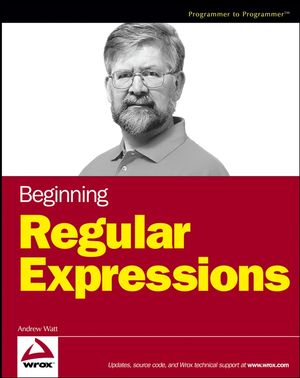Beginning Regular ExpressionsISBN: 978-0-7645-7489-4
Paperback
768 pages
February 2005
 This title is out-of-print and not currently available for purchase from this site.
|
This book introduces the various parts of the construction of a
regular expression pattern, explains what they mean, and walks you
through working examples showing how they work and why they do what
they do. By working through the examples, you will build your
understanding of how to make regular expressions do what you want
them to do and avoid creating regular expressions that don’t
meet your intentions.
Beginning chapters introduce regular expressions and show you a method you can use to break down a text manipulation problem into component parts so that you can make an intelligent choice about constructing a regular expression pattern that matches what you want it to match and avoids matching unwanted text.
To solve more complex problems, you should set out a problem definition and progressively refine it to express it in English in a way that corresponds to a regular expression pattern that does what you want it to do.
The second part of the book devotes a chapter to each of several technologies available on the Windows platform. You are shown how to use each tool or language with regular expressions (for example, how to do a lookahead in Perl or create a named variable in C#).
Regular expressions can be useful in applications such as Microsoft Word, OpenOffice.org Writer, Microsoft Excel, and Microsoft Access. A chapter is devoted to each.
In addition, tools such as the little-known Windows findstr utility and the commercial PowerGrep tool each have a chapter showing how they can be used to solve text manipulation tasks that span multiple files.
The use of regular expressions in the MySQL and Microsoft SQL Server databases are also demonstrated.
Several programming languages have a chapter describing the metacharacters available for use in those languages together with demonstrations of how the objects or classes of that language can be used with regular expressions. The languages covered are VBScript, Javascript, Visual Basic .NET, C#, PHP, Java, and Perl.
XML is used increasingly to store textual data. The W3C XML Schema definition language can use regular expressions to automatically validate data in an XML document. W3C XML Schema has a chapter demonstrating how regular expressions can be used with the xs:pattern element.
Chapters 1 through 10 describe the component parts of regular expression patterns and show you what they do and how they can be used with a variety of text manipulation tools and languages. You should work through these chapters in order and build up your understanding of regular expressions.
The book then devotes a chapter to each of several text manipulation tools and programming languages. These chapters assume knowledge from Chapters 1 through 10, but you can dip into the tool-specific and language-specific chapters in any order you want.
Beginning chapters introduce regular expressions and show you a method you can use to break down a text manipulation problem into component parts so that you can make an intelligent choice about constructing a regular expression pattern that matches what you want it to match and avoids matching unwanted text.
To solve more complex problems, you should set out a problem definition and progressively refine it to express it in English in a way that corresponds to a regular expression pattern that does what you want it to do.
The second part of the book devotes a chapter to each of several technologies available on the Windows platform. You are shown how to use each tool or language with regular expressions (for example, how to do a lookahead in Perl or create a named variable in C#).
Regular expressions can be useful in applications such as Microsoft Word, OpenOffice.org Writer, Microsoft Excel, and Microsoft Access. A chapter is devoted to each.
In addition, tools such as the little-known Windows findstr utility and the commercial PowerGrep tool each have a chapter showing how they can be used to solve text manipulation tasks that span multiple files.
The use of regular expressions in the MySQL and Microsoft SQL Server databases are also demonstrated.
Several programming languages have a chapter describing the metacharacters available for use in those languages together with demonstrations of how the objects or classes of that language can be used with regular expressions. The languages covered are VBScript, Javascript, Visual Basic .NET, C#, PHP, Java, and Perl.
XML is used increasingly to store textual data. The W3C XML Schema definition language can use regular expressions to automatically validate data in an XML document. W3C XML Schema has a chapter demonstrating how regular expressions can be used with the xs:pattern element.
Chapters 1 through 10 describe the component parts of regular expression patterns and show you what they do and how they can be used with a variety of text manipulation tools and languages. You should work through these chapters in order and build up your understanding of regular expressions.
The book then devotes a chapter to each of several text manipulation tools and programming languages. These chapters assume knowledge from Chapters 1 through 10, but you can dip into the tool-specific and language-specific chapters in any order you want.



